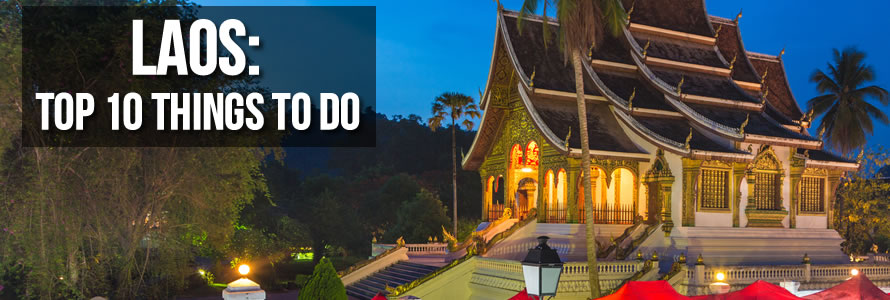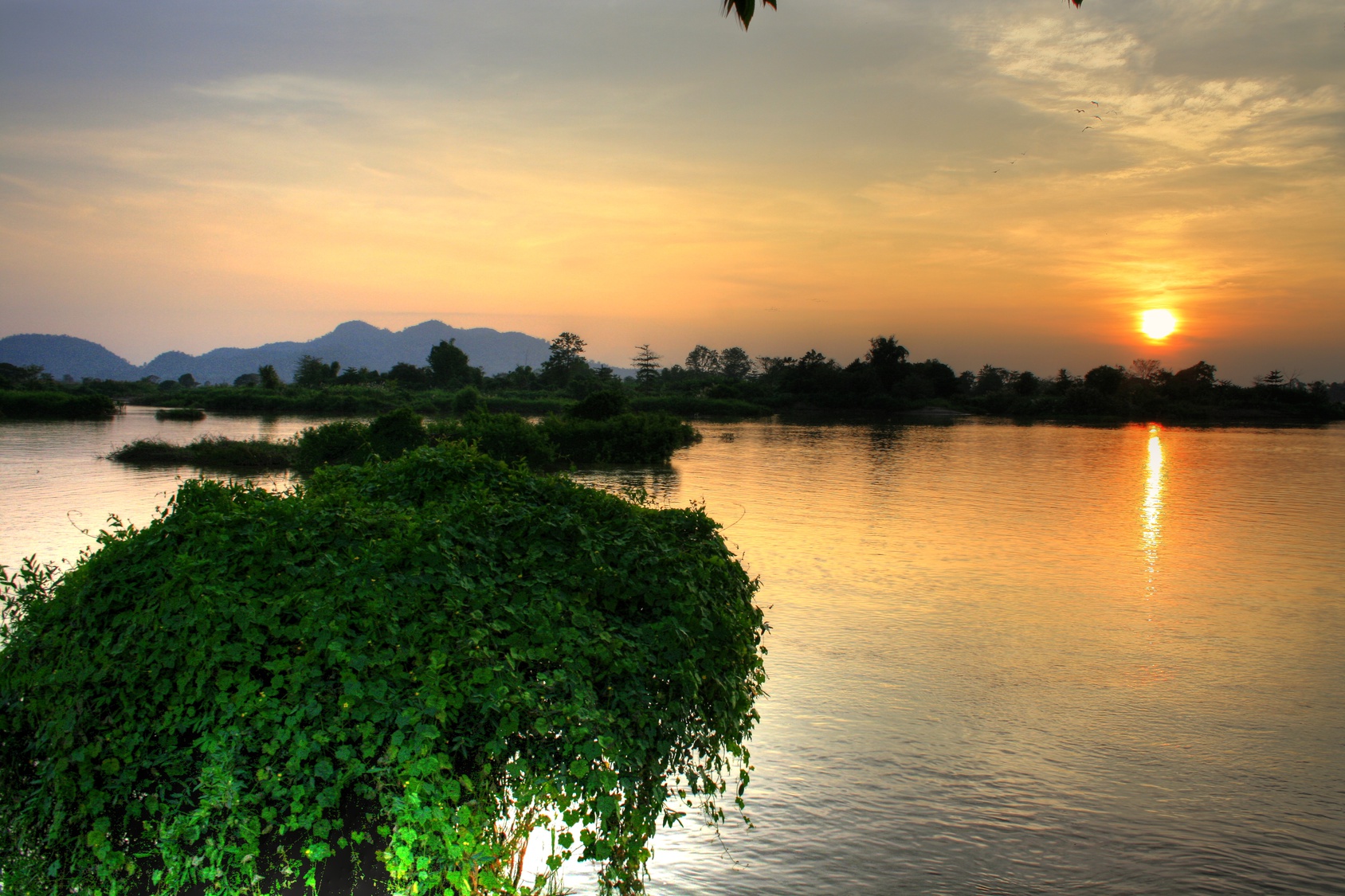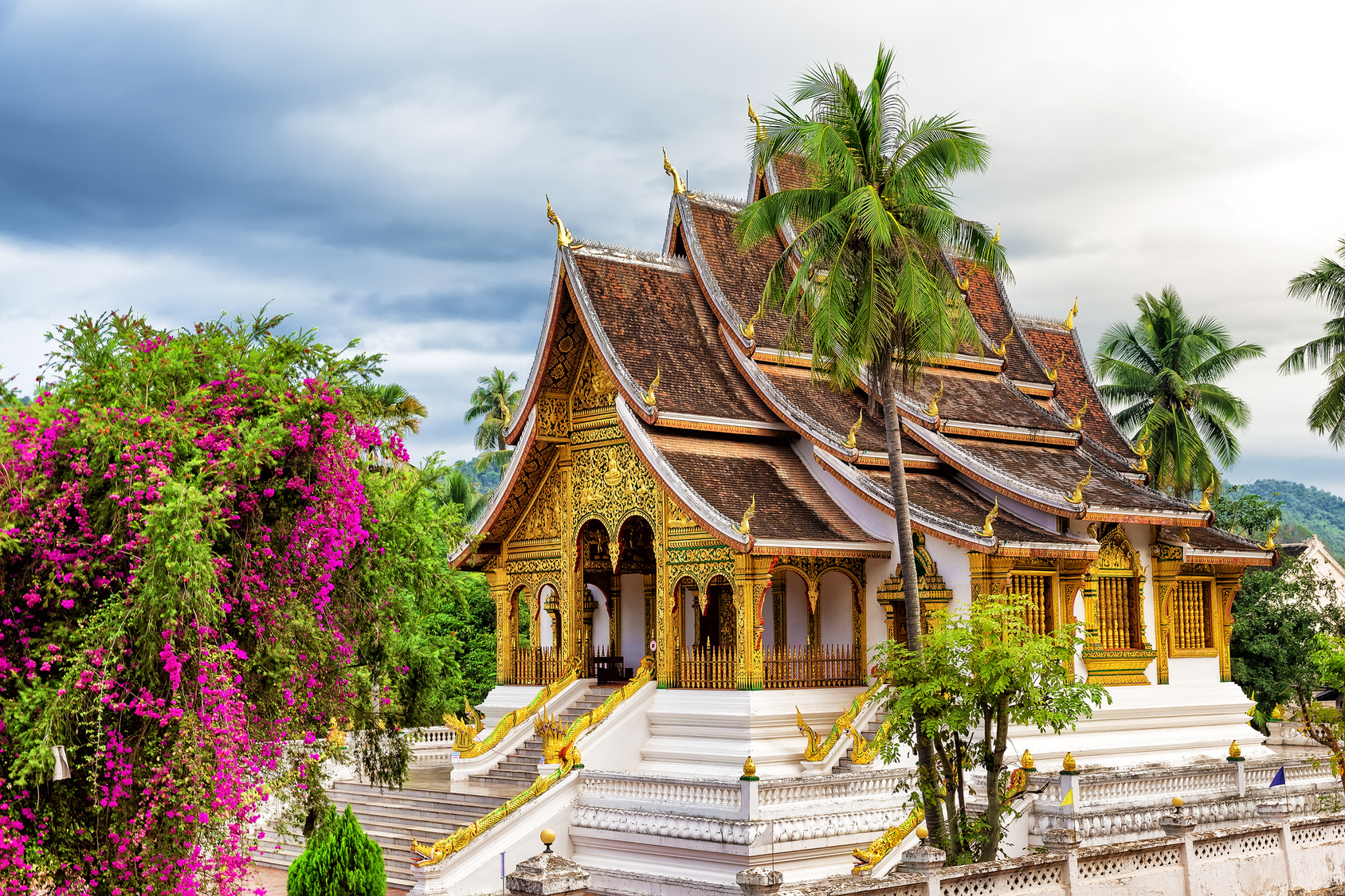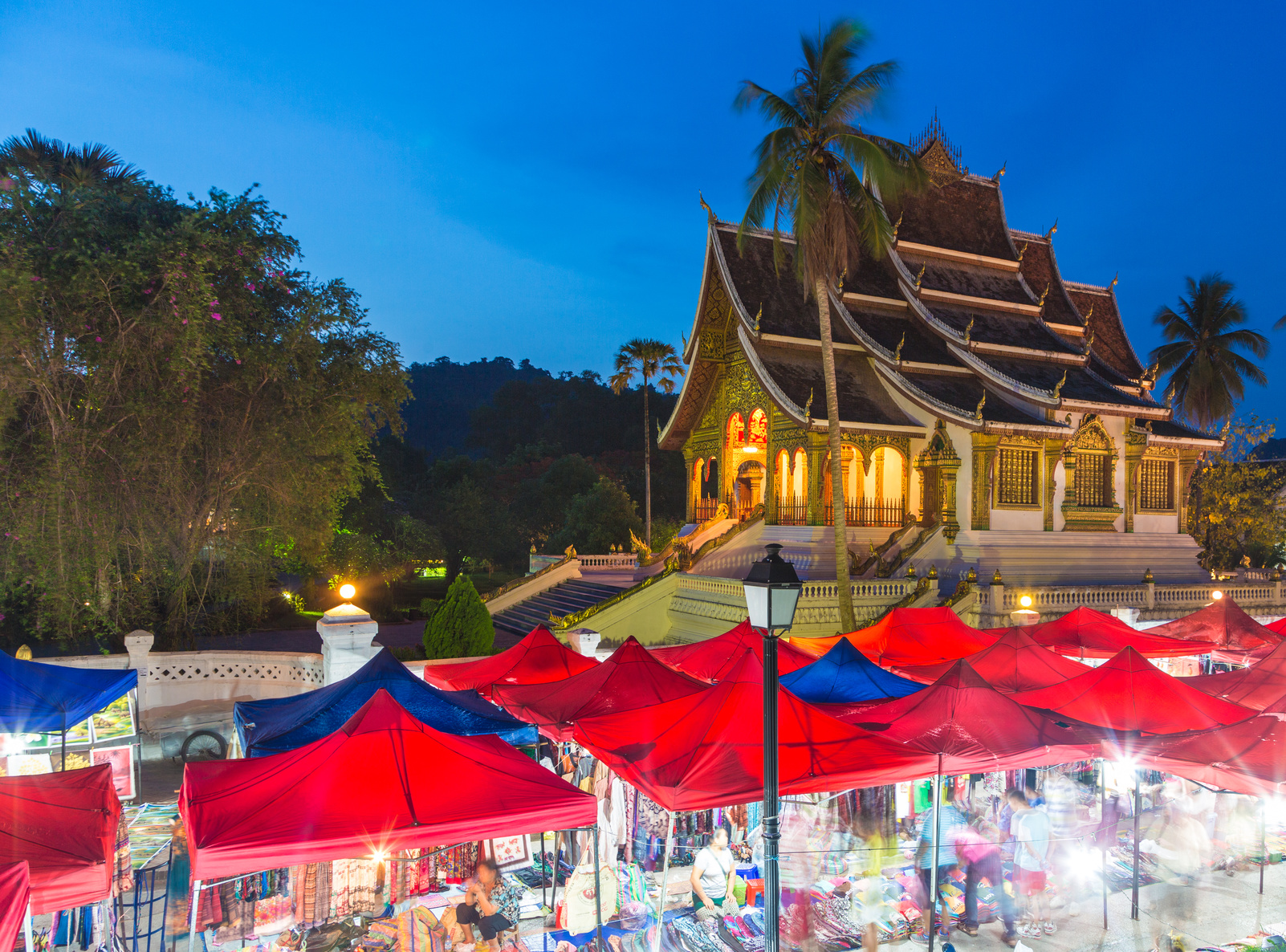Land-locked and small, Laos often gets overlooked, surrounded as it is by its well-established tourist industry neighbours of Thailand, Vietnam and Cambodia. However, Laos is packed with the fascinating and the spectacular, particularly for the traveller seeking an escape from the hordes and in search of the less-developed South East Asian experience. Dramatic limestone mountains, dense jungle, tons of caves and waterfalls and a high proportion of ethnic people and hill-tribe communities; these are just some of the reasons why travellers are now including Laos on their SE Asia circuit.
1) Kuang Si Falls – South of Luang Prabang
‘Ooo I want to go there’ tends to be the most common reaction when anyone sees a picture of the stunning Kuang Si falls. These tiered waterfalls, each level gifting a natural swimming pool of vibrant turquoise coloured waters, are almost impossibly beautiful. Surrounded by lush jungle, the waterfalls make up a scene as idyllic as you will find anywhere on the planet and you’re going to be hard pushed to decide between spending all you time cooling off in the pools or clicking away with your camera to capture the breath-taking beauty of it all to keep with you forever.
To get some views of the pools from above take the trail alongside which ends at a 60 metre cascade. This site is a little tricky to get to but there are a wealth of van, truck and tuk-tuk operators in Luang Prabang operating shuttle runs to and from the falls.
2) Si Phan Don or Four Thousand Islands
In the extreme south of Laos can be found the ultimately tranquil, Mekong surrounded archipelago known by most travellers as Four Thousand Islands. As the name might suggest there are quite a few islands here but visitors really only have a choice of three. Those looking for something a little more upmarket (comparatively speaking) opt for Don Khong – the largest – while most of the backpackers rock up to Don Det and Don Khon. These last two are joined by a bridge and everything is small enough to explore on foot or by bike and mega-cheap bike rentals are numerous.
Many of the budget-friendly hut-like accommodation on Don Det – which has more going on than Don Khon in the way of bars and places to eat – line the banks of the Mekong. Make your way to the beach at the south of Don Khon where a ridiculously small amount of money will buy you a seat (loosely speaking) on a small wooden boat piloted by one of the locals. The river journey, right on the Cambodian border, is worth it alone but the real draw here is the presence of a few incredibly rare and highly endangered Irrawaddy River dolphins. Time your trip for around sundown and not only are you likely to have the boat all to yourself but you’ll get to enjoy a ride home on waters which have been painted orange, pink and gold by the sunset.
3) The Plain of Jars
Scattered over a vast area in southern Laos are thousands of ancient stone jars – some standing solitary, some clustered by the hundreds. Historians tell us these jars, hewn from solid rock and ranging in height and circumference from 1 to 3 metres, date back to the Iron Age and are associated in some way with human burial. Archaeologists have uncovered human remains along with funeral objects to support this theory but otherwise little is known about these enigmatic megaliths dotting the plain here. During the Vietnam war this area suffered from heavy bombing by the U.S. Air Force causing not just irreparable damage to some jar sites and forming easily discernible craters but also leaving a landscape littered with unexploded bombs. This makes it impossible to wander freely here although rewarding exploration is still possible by following the marked pathways.
4) The Temples of Luang Prabang
Temples are so common in South East Asia it is hard to avoid them but nowhere has such a vast and varied concentration as Luang Prabang – once the capital of the kingdom. They come in every shape and size here, from modest single buildings the size of a shed to grand complexes and the saffron-robed Buddhist monks who inhabit them are everywhere. Many of the temples are so closely clustered little effort is required to move from one to the other but if you set a day aside to go temple gathering you can tick off more than 30 while wandering this incredibly beautiful city on foot.
Stumbling across little tucked away gems is a Luang Prabang highlight. To add a little adventure to your exploration venture across one of the wonderfully rickety bamboo bridges which are swept away by monsoon rains each year and then rebuilt. Chances are you will have the temples on the other side all to yourself save for the monks who just love to practice their English with any Westerner who makes it this far. The jewel in Luang Prabang’s temple crown is without doubt the astonishingly lovely Wat Xieng Thong complex with its rose-pink, gilt-gold sacred buildings plastered with glass mosaic tiles depicting stories and scenes, all a-twinkle when the sun catches them.
And just so you know – there is some etiquette involved when visiting temples. Wear modest clothing which covers both knees and shoulders, remove your shoes at the temple door and no touching or handing things to the monks if you happen to be female.
5) Buddha Park – Near Vientiene
Treat yourself to a slice of the slightly bizarre as the Asians do it and spend an hour or two at the outside sculpture gallery known as Buddha Park or Xieng Khuan, dating from the 1950s. This relatively small space is filled to bursting with more than 200 statues which draw influences from both Buddhism and Hinduism, depicting gods, demons, animals and humans intermingling ancient imagery with decidedly contemporary styling. The final product is an eclectic whole which somehow manages to be both moving and wacky at the same time. Notable highlights include a massive 40 metre long reclining Buddha while great park views can be had by climbing through the demon’s mouth portal at the base of a pumpkin-like sculpture. The three levels you pass through to emerge at the top represent Hell, Earth and Heaven.
6) Visit an Ethnic Tribe Village
Statistics are a bit blurry with regard to the percentage of the population in Laos which claim ethnic origin and as always where minority and indigenous peoples are concerned the subject can be both an emotive and sensitive one. However, exact counts aside, some things are for sure – ethnic tribes are numerous, incredibly diverse and their fascinating cultures often highly individual and distinctly different. Many have their own language, their own mode of dress and very separate belief systems to otherwise Buddhist-dominated Laos, often taking the form of animism.
With so many tourists eager to experience something of such different cultures a few operators have sprung into being offering tours which are comfortable and super slick but somewhat manufactured. However, genuine experiences are possible and although incredibly fascinating are not always comfortable when viewed through Western eyes.
One such is a visit to a Kata village in the Bolaven Plateau region where your tour guide is a village member himself and with all profits used from your fee for the benefit of the community. Each large stilt-raised bamboo hut under which the pigs, chickens, dogs and sometimes naked children laze about seeking shelter from the sun, houses several families. Each family unit is typically composed of one man with an average of six wives, some as young as thirteen. Water supply is by way of a centrally located hand-pump which serves the whole village; all here smoke water-pipes filled with a special ‘tobacco’ blend including the children and animals are sacrificed to appease the spirits.
These types of experiences may not be for the sensitive but they are essential if you are truly interested in understanding how significant parts of Laos society and culture are made up.
7) The Vang Vieng Caves
Vang Vieng was once known for its drunken river tubing before successive years resulted in fatal accidents to highly intoxicated Westerners taking part. After this the authorities moved in and shut down or destroyed most of the bars en route. It is still the place where many restaurants offer both normal menus and ‘happy’ menus – the latter offering the same food but laced with a variety of drugs including opium. However, dramatic karst cliffs-surrounded Vang Vieng has much more going for it than simply this hedonistic side.
Hill hiking is popular and so too is exploring the many incredible caves. These come in a variety of forms such as the beautifully and atmospherically-lit Chang cave with its easily negotiated pathways and lovely natural swimming hole right outside from which you can actually swim into the cave.
The other end of the caving scale – represented by such as Poukham cave – will have ultimate appeal for the adventurous. You’ll need to bring your flash-light here because once you pass the golden reclining Buddha near the entrance the natural daylight will gradually disappear and you’ll have to make your way, clambering over rocks and negotiating sudden drops as you go, in the pitch dark. You can easily lose hours in this vast stalactite-filled catacomb but when you’ve had your fill there is some lovely swimming in the river outside, complete with rope swings and a large grassy area.
8) The Dawn Alms Procession in Luang Prabang
You’ll have to set your alarm clock early for this one but it is well worth it. The sight of sometimes hundreds of saffron-robed, bare-foot Buddhist monks snaking in procession through the streets of Luang Prabang in the pre-dawn light is a moving spectacle. Just when you think it is all finished another line will appear. This sacred ritual is a daily event and although it is a huge tourist draw it is not something organised for the benefit of Luang Prabang’s visitors. Rather, this is a solemn tradition by which means the monks of the city get their daily food rations. Each monk carries his alms bowl which the local Buddhist faithful will fill with rice and such like from their cross-legged seated position on the pavement.
9) Trekking
Laos has such a wealth of incredible trekking opportunities some come here for that reason alone. Hiking opportunities come in all shapes and sizes from short self-guided hikes to multi-day guided tramps and from strolls on marked pathways to deep-into-the-wilderness trails guaranteed to challenge even the most committed hiker.
The great beauty of hiking is that not only do you get to immerse yourself in some pristine nature but you are also afforded the opportunity to see the hidden places and people far removed from the usual tourist trail, in every sense of the word. Many hikes will take you to visit remote ethnic villages where the way of life has changed little in centuries. Otherwise expect lots of animal and bird-life, breathtaking waterfalls, awe-inspiring cave systems, mountain scenery, deep forest, river journeying and even ancient ruins. Over-nighting on multi-day hikes is typically in the form of home-stays which range from super-rustic to surprisingly comfortable.
One popular starting point for the hiker is the lovely riverside and mountain-hugged town of Nong Khiaw. Although a worthwhile destination in itself, this town seems to have developed into something of a hub for hiking tour operators which means you will have lots of choice here. On offer – besides the hiking – are all kinds of adventure activities and experiences which include kayaking, river journeying, bamboo raft workshops, cycling, rock climbing and various combos.
10) The Luang Prabang Night Market
Markets in general, the world over, are a great way to get instant access and immersion into a country’s culture. Nowhere is this truer than in South East Asia and the rainbow-hued night market in Luang Prabang is a perfect example. All day long the city’s main strip is a bustle of cars, tuk-tuks, scooters, locals going about their business and tourists checking out the temples. However, come sunset, the street is closed to traffic and the hill tribe vendors start to set up shop, laying out their wares in row upon row of seemingly never-ending stalls, totally transforming the feel and look of everything.
If you love shopping or browsing and are into your handicrafts you are quite possibly going to think you have died and gone to heaven. The bargains to be had are incredible (especially if you have good bartering skills) and some of the wares simply exquisite works of art. Expect elaborately worked silk scarves, embroidered bags, blankets and clothing in every shade known to man along with ceramics, lanterns, carved and metal-worked opium pipes, bamboo articles, baskets, paintings and just about everything else which might be contained under the handicraft umbrella including some truly individual items.
Even if you don’t intend to buy anything the buzz and colour of the night market, strung around with multi-coloured lights, are draw enough all on their own. Those in search of food will find amazingly cheap and authentically local eats down a side lane, which runs from the top end of the market, including an all-you-can-eat buffet perfect for the hungry backpacker on a mega budget.




